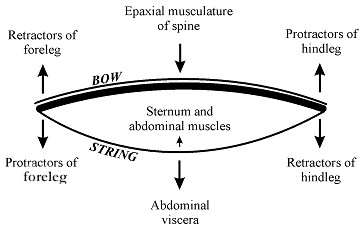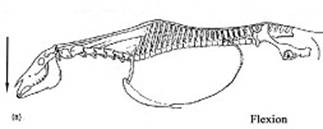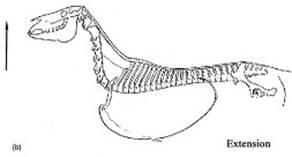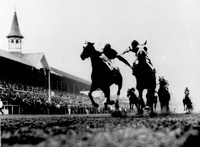
The Horse’s Back and BTB
There are some things that, once said, seem so fundamentally obvious that you have to wonder why they aren’t uppermost in your mind all the time and why you might ever need reminding, and here to start this article is one; the back is the most important structure in the ridden horse.
But if this complexity prevents the average owner from a detailed knowledge of spinal structure and operation there have to be some basics that we all take on and keep firmly in mind, since they impact heavily on our ability to maintain the horse’s wellbeing during work. And, if you are wondering where the ‘BTB’ (bitless-treeless-barefoot) comes into this then wonder no more. Bitless bridles, treeless saddles and barefoot trimming are all attempts to address problems caused by our use of horses, and each impacts on the operation of the back.
We may make a primary connection between bitless bridles and the mouth, but any pain caused directly in that area is really of secondary importance; what is of greatest concern is the impact on the back, and therefore the whole musculo-skeletal structure of the horse, as the horse attempts to avoid such pain, and the postural changes it goes through in the process.
We’ve touched on this before, but not in any detail, so perhaps we should go over the ground again as part of building up a holistic approach to what we put on our horses and what we ask of them once we have. Rather than describe the movement sequences in each of the four paces – walk, trot, canter and gallop – I’ve taken some ‘licence’ in coming up with a way of describing a composite of movement for the sake of discussion – so I hope purists will pardon the generalisations! And just so we keep a broadly scientific grounding throughout I’ve added quotes from scientific papers that have dealt with these issues.
First of all there have been several attempts to develop a diagram illustrating the basic design concept of the horse’s back; below is the most recent and generally considered to be most accurate.

This is known as the bow and string model, and although it may look a little complicated the principles are fairly straightforward.
The bow equals the spine between wither and tail and this, as is shown, is naturally braced in a convex curve, while the string roughly approximates the belly line. The sternum and abdominal muscles act to support the downward force on the belly, while the abdominal viscera pull down against the string. The epaxial musculature (def: above the axis of the spine) also exerts a downward or flattening effect. The muscles that extend the foreleg, or the protractors, exert downward pressure on the bow, while those that pull the foreleg back, the retractors, exert upward pressure – while with the hindleg this action is reversed.


As the head is lowered the ligaments that run from head to tail tighten, supporting the back; the foreleg swings forward (protract) and propulsion from the hindleg is transferred via the hip along the spine.


The head raises, ligament lengthens allowing foreleg to swing back (retract) and hindleg to swing forward.
So we have a constant cycle of flexion and extension while the horse is moving – but this only deals with the movement of the spine as if the horse’s body is in a straight line travelling over perfectly flat ground with no irregularities. In reality, horses are rarely, if ever, so straight, and ground surfaces, even those that appear quite flat have any number of minor or major irregularities. The vertebrae allow the horse to harmonise with the ground surface by rotating in 3 dimensions.
With the healthy horse in free action these forces flow through the spine to produce that beautiful harmony of movement and speed that we so admire – but in the ridden horse there are extra forces at play that are not part of the natural design concept and can have a major impact.
So let’s go through flexion and extension again with rider weight added. We’ll say that rider weight is, in this case, not extreme as a percentage of the horse’s own body weight, that the horse is reasonably fit and has been given reasonable preparation before being asked to perform under this extra burden, and let’s assume that we won’t cause too much of a problem.
During flexion the tightening of the ligaments supports the back against the downward pressure of rider weight, but at extension the back is less well supported and rider weight impacts more heavily making it more difficult to retract the foreleg and bring the hindleg forward under the body ready for the next flexion phase.
• The movements of the back directly influence the head and neck position. With a high head and neck position, the stride length and extension of the back are significantly reduced. The neck can be a useful measure of stretch through the back as well as stride length. ( Rhodin, M., Johnston, C., Holm, K.R., Wennerstrand, J. and Drevemo, S. (2005) The influence of head and neck position on kinematics of the back in riding horses at the walk and trot. Equine Vet J 37, 7-11.)
If we now consider the same situation, but with a heavy rider, it becomes very clear that the spine will be operating under far greater stress. There is no question that such a horse will tire more rapidly and will be more likely to stumble as the energy required to bring hindleg forward and retract foreleg is increased. But we have only just begun to consider the interference we impose – at this point our model is working with neither bridle and bit nor saddle – so let’s add those in next.
Bit and bridle first, and we’ll assume that not only is our rider a good weight for the size of the horse but that they are fit and well trained. So what we are really assuming here is that the combination of bit, bridle and rider are having no effect on the movement, and are merely following it with the lightest of contact. But what if our rider is not quite fit or well trained? During flexion the head, instead of being able to move freely forward and down, has to drag the weight of the rider’s hands, arms and upper body forward while at the same time supporting, in fact actively lifting, the extra weight. As the extension phase occurs, the rein contact changes, requiring some adjustment in gait. Our rider shortens the loosened reins just in time for the head to go forward again, and instead of the head being able to go smoothly down and forward it is checked with an increase in pressure on the tissue of the mouth and gums. In an effort to adapt to these changes the muscular tension increases, the process becomes more tiring still, and the flow of one phase into another is less smooth. No doubt there is also an element of irritation involved, as the horse is well aware of how easy the same movement is without rider interference.
• Movement of the back at the wither is significantly reduced in the ridden horse (Townsend, H.G., Leach, D. and Fretz, P.B. (1983): Kinematics of the equine thoracolumbar spine. Equine vet. J. 15, 117-122.)
Now add a rigid saddle.
• Without a rider, the saddle still exerts force, due to vertical acceleration - particularly in trot where it shows a marked up / down motion. (Peham, C. and Schobesberger, H. (2004) Influence of the load of a rider or of a region with increased stiffness on the equine back: a modelling study. Equine vet. J. 37, 703-705.)
Obviously there is a question of added weight, but on top of that the points of the tree impede the free movement of the shoulders and tend to dig in or at the very least cause a pulse of increased pressure when the back is least supported at the start of extension.
• Tree pressure points can cause pain, muscle wastage, problems related to the willingness of the horse to be ridden, moving the back away from the underneath of the saddle, stiffness in lateroflexion, dorsoflexion, and ventroflexion, and difficulties in transitions as well as in collection. (Nyikos, S., Werner, D., Müller, J. A., Buess, C., Keel, R., Kalpen, A., Vontobel, H. D., Plocki, K. A. von, Auer, J. A., Rechenberg, B. von (2005) Measurements of saddle pressure in conjunction with back problems in horses. (Pferdeheilkunde, 2005 (Vol. 21) (No. 3) 187-198Nyikos at al., 2005.)
As the vertebra rotate in order to compensate for unevenness in the ground surface they are either restricted by the rigidity of the saddle or buffeted by increased contact and pressure between back and underside of the saddle – and if we then put our heavy rider back on the model, give them poor rein contact and an uncomfortable bit, we have all the components of a potentially miserable experience for the horse.
• The range of motion of the ridden horse is significantly lower than that of the unridden horse. If a saddle provokes localized pressure concentrations, the horse terminates the forward swing of the leg and stride length decreases. (Peham, C. and Schobesberger, H. (2004) Influence of the load of a rider or of a region with increased stiffness on the equine back: a modelling study. Equine vet. J. 37, 703-705.)
And if that was not enough, we’ll also fix rigid metal shoes that alter the nature of the foot’s impact with the ground, the potential for the toe to cut in and greatly reduce shock-absorption and the safe distribution of heat away from the concussive surface, and there is absolutely no surprise that we might easily exceed the tolerance of the structure – with back ache, overflexion of joints and lameness the outcome. But even if none of those happen and the structure is not clinically damaged we can expect the living creature that inhabits our model to be less than enthusiastic about performing.
• The influence of a saddle with weight can best be described as an overall extension or hollowing of the back. This may contribute to soft tissue injuries and Kissing Spines Syndrome. (DeCocq, P., van Weeren, P.R. and Back, W. (2004) Effects of girth, saddle and weight on movements of the horse. Equine vet. J. 36, 758-763.)
No wonder then that they attempt to take control of the bit, or fight its pressure. The rider might think they are pretty stupid to do so and that all they have to do is relax and stop pulling for comfort to return – but the horse knows too well that it was discomfort that made him try to take back the control over his own body that he is used to having when this damned lump is not in his mouth and on his back!
• A kind horse may become awkward and rather fractious. This may be seen as a loss of enthusiasm for work. There may be a disinclination to jump, particularly the combination-type fences…or a horse may lose its fluidity and timing and tend to rush his fences. (Jeffcott, L. B., 1975: The diagnosis of diseases of the horse's back. Equine Vet. J. 7, 69-78. 1975)
Having gone through this over-view process let’s now bring the discussion around to the practical realities of what we can do to decrease the negative aspects of riding.

And while the hackamore certainly gets rid of the bit it still operates on the basis of pain/discomfort by allowing the rider to exert pressure on the ‘chin-groove’ and nose by way of leverage. Once again the rider’s hands dictate how much interference there will be. Given a knowledgeable rider that is aware of the mechanical advantage offered by the leverage and a good degree of sensitivity in terms of how such force might reasonably be applied, plus a level of physical fitness so that the hands are able to act at all times independently of the rider’s torso, the hackamore is not a bad device. But where any of these conditions are missing, or where harsh designs are used, such as those made with sharp curb chains or chunks of bicycle chain (leather covered or not) over the nose, what you actually end up with is something that can do even more damage. So while the hackamore gets rid of pain in the mouth it tends merely to transfer it elsewhere – with equally bad or worse effects on posture and movement.
The present trend for using treeless saddles was also a response to the problems of tree’d saddles.
Around the late 1990s the results of scientific research into the effect of conventional saddles on back problems and lameness caused owners and innovative saddlers to begin designing alternatives. Typically the problems they were attempting to solve were to do with the conventional saddles inability to flex through those same 3 dimensions as the vertebra so that, even where saddle fit was good on the standing horse, it simply could not match the changes of shape that occur in the back during movement. And, as discussion of these alternatives grew, it also became increasingly obvious that while some riders had the resources to ensure saddles fitted as well as possible and were made to a high standard many did not.
• 73% of a group of horses showed uneven saddle panels causing significant pressure on the back, with 57% showing back pain and muscle atrophy from saddles with serious multiple fitting problems. (Harman, J.C. (1997) Measurements of the pressures exerted by saddles on the horse’s back using a computerized pressure measuring device. Pferdeheilk. 13, 129-134)
In some cases the problem was that sellers simply didn’t concern themselves overly much with ensuring a good fit.
• Saddles are sold with little consideration of fit and even less knowledge about the consequences of poor fit. (Harman JC (1999). Tack and saddle fit. Vet. Clin. N. Am.: Equine. Pract. 15: 247–261.)
But whatever the reason, research showed that poor fit and unevenness was the source of a great many problems, and established clear trains of cause and effect.
• Poor saddle fit is among the major causes of back pain among horses. (Jeffcott, L.B., et. al., 1999.
Validity of Saddle Pressure Measurements Using Force Sensing Array Technology - Preliminary Studies.
The Veterinary Journal, Vol 158: 113-119.)
It is certainly true that the intention of treeless saddles was to prevent these problems occurring, but any type of saddle used by a rider whose weight is either too great, or is concentrated over too small an area, will cause problems – treeless or not.
• Saddle fit and rider weight distribution are an important aspect of ability to move freely. (Peham et al 2004)
So the claims made by some vendors when treeless saddles came onto the market – that their saddles would work on any shape or type of horse and would cure all kinds of problems – were simply not justified. Although the treeless saddle offers a different set of options, the complexities of the equine back and the interaction between it and rider weight offer a challenge that requires attention to detail and the development of designs suited to specific combinations of horse, rider and activity.
Since NHP began this subject has been an integral part of our journey of discovery, and once we had begun to try a few types out and to develop our own ideas it seemed a natural extension to establish a line of saddles and accessories that would fulfil the ethical imperative that every horse should be able to work in the greatest degree of comfort and safety, and with the least possible impact on natural fluency of movement.
© Andy Beck – W.H.E.E.P. 2006
Trackback URL : 이 글에는 트랙백을 보낼 수 없습니다
Trackback RSS : http://www.fallight.com/rss/trackback/1356
Trackback ATOM : http://www.fallight.com/atom/trackback/1356







